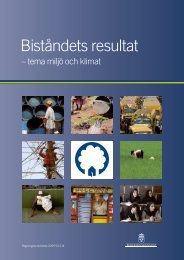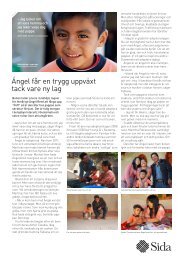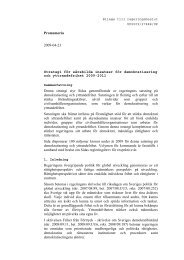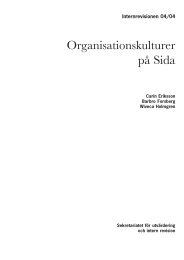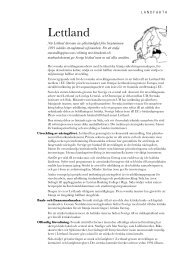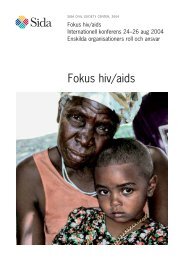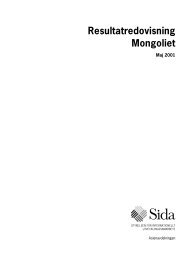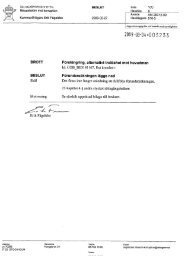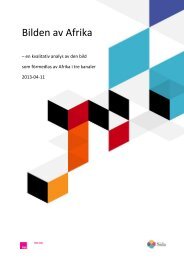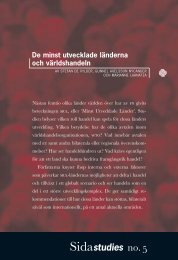Mobilisation of the Poor – a means to Poverty Reduction? - Sida
Mobilisation of the Poor – a means to Poverty Reduction? - Sida
Mobilisation of the Poor – a means to Poverty Reduction? - Sida
You also want an ePaper? Increase the reach of your titles
YUMPU automatically turns print PDFs into web optimized ePapers that Google loves.
26<br />
Case 5: A CAP Small Group that Became less Active over <strong>the</strong> Years<br />
C Group in Weli Oya is one <strong>of</strong> <strong>the</strong> small groups formed under <strong>the</strong> PRDP in <strong>the</strong> North Central Province. PRDP<br />
was a special project supported by <strong>Sida</strong> where a version <strong>of</strong> <strong>the</strong> CAP methodology has been used. One <strong>of</strong> <strong>the</strong><br />
special features <strong>of</strong> this project was <strong>the</strong> large-scale and rapid recruitment and training <strong>of</strong> mobilisers who were<br />
paid a special monthly allowance. C Group was formed in 1994 with eight members <strong>–</strong> three men and five<br />
women. By 2001 <strong>the</strong> group contained four women only. Interestingly, <strong>the</strong> reduced small group contained a<br />
married woman named Sagarika (who was <strong>the</strong> leader <strong>of</strong> <strong>the</strong> group), her sister, her mo<strong>the</strong>r, and her mo<strong>the</strong>rin-law.<br />
The four members lived in four separate households but were in close contact with each o<strong>the</strong>r. Even<br />
among <strong>the</strong> remaining four members one was reported <strong>to</strong> be less active as <strong>of</strong> May 2001. Before <strong>the</strong> break<br />
up <strong>of</strong> <strong>the</strong> group that occurred in March 2001, <strong>the</strong> group fund amounted <strong>to</strong> Rs.9000. As <strong>of</strong> May 2001 it had<br />
shrunk <strong>to</strong> a mere Rs.1000, kept by Sagarika. According <strong>to</strong> her, some <strong>of</strong> <strong>the</strong> male members <strong>of</strong> <strong>the</strong> group left<br />
when <strong>the</strong>y got jobs outside <strong>of</strong> <strong>the</strong> village. Also, some members found it difficult <strong>to</strong> contribute <strong>the</strong> agreed<br />
weekly or fortnightly payment for <strong>the</strong> group savings scheme because <strong>of</strong> <strong>the</strong>ir poverty and lack <strong>of</strong> regular<br />
income. Fur<strong>the</strong>r, <strong>the</strong> mobilisers responsible for local group formation left <strong>the</strong> project when <strong>the</strong>ir allowances<br />
was terminated and responsibility for maintaining <strong>the</strong> group process had now been shifted <strong>to</strong> <strong>the</strong> newly<br />
formed PO. This was seen as ano<strong>the</strong>r fac<strong>to</strong>r contributing <strong>to</strong> <strong>the</strong> weakening <strong>of</strong> small groups in <strong>the</strong> area.<br />
The CAP small groups in <strong>the</strong> area had been quite active in 1995<strong>–</strong>96. At that time, in addition <strong>to</strong> regular<br />
meetings, group savings and credit operations, labour sharing among members, as well as bulk purchasing<br />
<strong>of</strong> commodities, were a common occurrence. Sagarika emphasised that even though <strong>the</strong> group had become<br />
smaller it continued with regular meetings and savings and credit operations and participated in village-wide<br />
activities like shramadana work which was organised collectively by all <strong>the</strong> remaining small groups in <strong>the</strong><br />
area. She also noted that <strong>the</strong> current activities presented no special problems as <strong>the</strong> remaining members<br />
were all part <strong>of</strong> <strong>the</strong> same family. Even though <strong>the</strong> number and scale <strong>of</strong> operations had obviously decreased<br />
with <strong>the</strong> decrease in size <strong>of</strong> <strong>the</strong> group, some rudimentary activities like fortnightly savings and lending<br />
continued among this core <strong>of</strong> relatives. While <strong>the</strong> group process has obviously become weaker because <strong>of</strong><br />
internal and external pressures, <strong>the</strong> ability <strong>of</strong> <strong>the</strong> groups <strong>to</strong> survive in a rudimentary manner indicates a<br />
degree <strong>of</strong> resilience in <strong>the</strong> group process.<br />
Third, in view <strong>of</strong> <strong>the</strong> centrally administered and supervised nature <strong>of</strong> <strong>the</strong> Samurdhi programme,<br />
financial systems tended <strong>to</strong> be better organised and more in keeping with a standardised system.<br />
Finally, <strong>the</strong> Samurdhi organisations were widely used as part <strong>of</strong> <strong>the</strong> state delivery mechanism for<br />
<strong>the</strong> distribution <strong>of</strong> resources <strong>to</strong> <strong>the</strong> rural poor. This, in turn, had implications for creating or<br />
enhancing dependency. In contrast, <strong>the</strong> emphasis on self-reliance was much more pronounced in<br />
CAP, even though this tendency has been somewhat weakened by <strong>the</strong> increased importance <strong>of</strong><br />
access <strong>to</strong> credit as an incentive for joining.<br />
MOBILISATION OF THE POOR <strong>–</strong> A MEANS TO POVERTY REDUCTION <strong>–</strong> <strong>Sida</strong> EVALUATION 02/08




